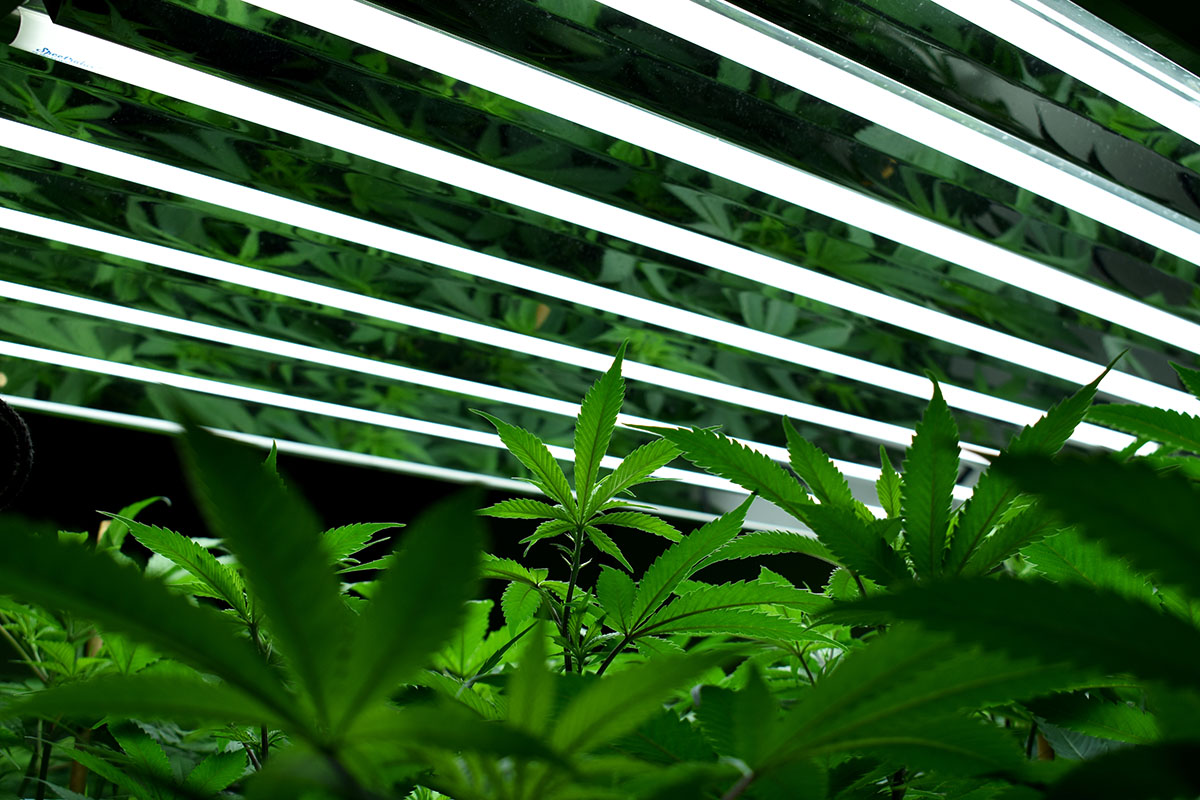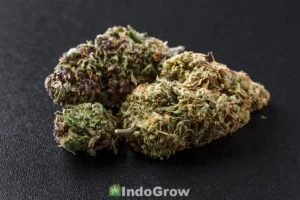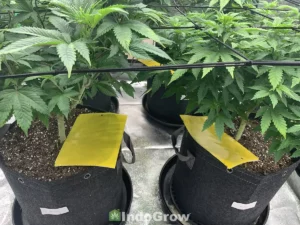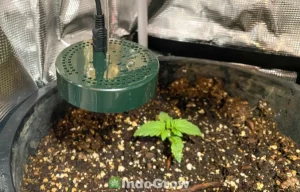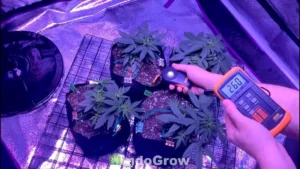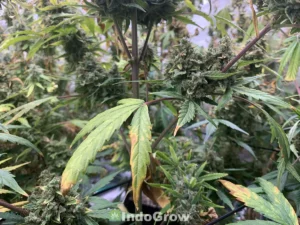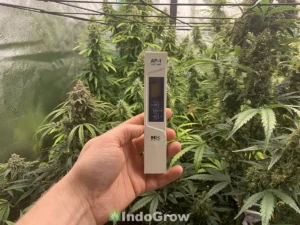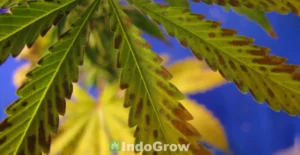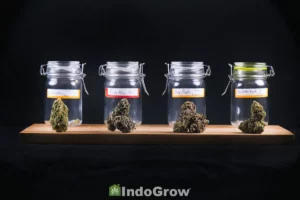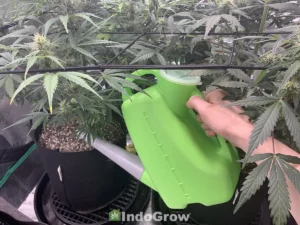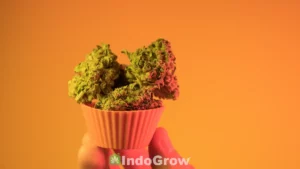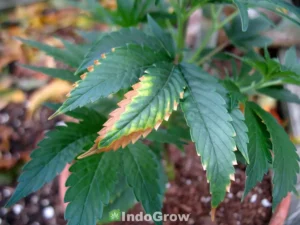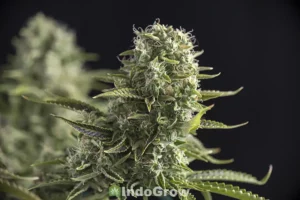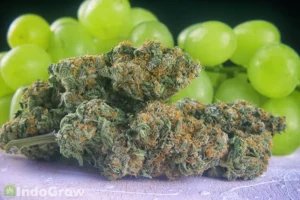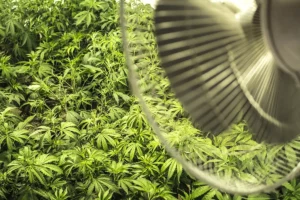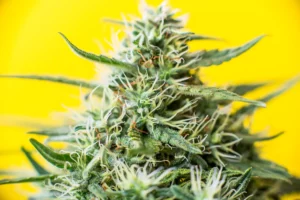When determining a grow room design, you must first consider how many plants you want to grow, as well as how much time, space, and money you have to devote to growing cannabis. Common grow room setups for home growers include light only grows, grow tents, a converted closet or cupboard, or a full room grow.
Next, you will need to purchase materials such as exhaust and oscillating fans, LED lights and fixtures, and climate control units such as humidifiers, dehumidifiers, AC units, and heaters.
Once you select a location for your grow and install the necessary hardware, you will be ready to add your plants and begin growing! Read on to learn more about setting up the perfect grow room for your growing situation.
Table of Contents
- Indoor Grow Room Supplies
- Grow Room Design Plans
- Small Grow Room Design
- Choosing a Grow Area
- Grow Tent Setup
- Add Exhaust Fan to Grow Tent
- Installing Carbon Filter in Grow Tent
- Add Grow Light to Grow Tent
- Add Circulating Fans to Grow Tent
- Add a Humidifer, Dehumidifier, Portable AC Unit, and Heater as Needed
- How to Setup a Closet or Cupboard Grow Room
- How to Setup a Basic Light-Only Grow Space
- How to Build a Full-Room Grow Room
- Add Exhaust Fan(s) to the Grow Room
- Where to Put Carbon Filter in Grow Room?
- Add Grow Lights to the Grow Room
- How to Setup Circulating Fans in Grow Room?
- How to Build a Sealed Grow Room?
- How to Build a Grow Room in a Basement?
- Summary
Indoor Grow Room Supplies
Before setting up a grow room for your cannabis plants, you will need to purchase some materials. First, decide if you will be growing in tents or in an entire room/cupboard/closet. You will either need to buy one or more grow tents or purchase enough light proof reflective mylar film to cover the walls, windows, and doors of your grow room. If your grow room has carpet, you should also cover this in watertight reflective film to prevent mold.
Next, you will need to purchase some growing equipment. Standard equipment includes LED or other grow lights, an exhaust fan with charcoal filter and ducting, and circulating fans. Many grow tents or rooms also make use of humidifiers, dehumidifiers, AC units, or portable heaters depending on the climate of the grow area.
Grow Room Design Plans
The four primary design options for a home grow are: a light only grow, one or more grow tents in a room, a converted closet or cupboard grow, and a full room grow.
A light only grow involves placing one or more cannabis plants under grow lights in a room that is not climate controlled. Although it is possible to grow cannabis to flower very cheaply using this method, your yields will likely be very poor. Light from windows or other rooms may confuse the plant and delay flowering, while improper humidity or temperature conditions around the plant may slow or stunt growth.
The next, and most reliable, option is to grow your cannabis plants in one or more grow tents. Grow tents can be set up in a spare room, and are designed to create an optimal climate for your marijuana plants. Grow tents will come equipped with reflective walls, support beams for hanging lights and other equipment, and holes for intake and exhaust air flow.
Another reasonable option is to convert an unused closet or cupboard into a grow room. These small spaces are ideal for growing one or a few cannabis plants, and they can be easily wrapped in reflective film to maximize lighting. The major drawback to this method is that cupboards and closets often have very poor ventilation, and you may have to make serious modifications to the walls or doors to install exhaust fans and intake vents.
The final option for a large home grow is to convert an entire spare room into a grow space for your plants. This can be a major undertaking, as you must fit the entire room with reflective film, a large number of grow lights, and multiple fans to circulate air around the space. The room must have sufficient outlets for plugging in your lights, fans, and other equipment, as well as a window or other place to vent exhaust air through.
Small Grow Room Design
The ideal choices for a small grow room are a grow tent or a converted closet or cupboard. Large rooms may also be used for home grows, although it is often more efficient to place 2 or more tents in a large room rather than trying to convert the entire room into a single grow area. Having more than one tent also allows you to stagger your grows, with vegetative plants in one tent and flowering plants in another.
A single plant and grow light can also be placed out in the open in a larger room, as long as that room is properly climate controlled and does not expose the plant to direct sunlight.
Choosing a Grow Area
Choose a location that has a stable climate with minimal fluctuations in temperature and humidity. Garages or unfinished basements may be unsuitable for this reason.
Your grow area should also have access to a bare minimum of one wall outlet, since you will need to plug in grow lights, fans, and other climate control equipment.
Choose an area that has reasonable access to water, as well as a window, door, or vent to run your exhaust air out of. Remember that the air inside the room will smell strongly of marijuana, especially during the flowering stage, so be careful where you vent air if you have privacy concerns for your grow.w
Rooms with carpet or wallpaper may be unsuitable for growing cannabis, as these surfaces can harbor potentially dangerous mold if they become too damp. If a room with carpet or wallpaper is your only option, using grow tents can help protect wallpaper, while putting down a reflective, waterproof tarp can help protect carpet. If a musty smell develops, you may have to lower the humidity or move your plants elsewhere, since excessive mold spores in the air can be a health concern for both you and your plants.
Grow Tent Setup
Popular grow tent sizes include 2×4, 3×3, 4×4, and 5×5 feet. The height of your tent will scale with the size of the footprint of the tent, but they are usually between 6-7 feet tall. Although most plants will not grow this tall, the top couple feet of your grow tent will likely be taken up by lights and fans.
You can place your tent in any climate controlled room with enough space to hold it. Be sure to leave yourself enough room to maneuver around the outside of the tent for maintenance. Larger rooms may be able to accommodate multiple tents, allowing you to grow multiple strains or multiple life stages of cannabis in the same room.
Your tent will come with instructions from the manufacturer on how to assemble. For most tents, you will first assemble the metal skeleton of the tent, then slide the unzipped tent tarp over top. Once this is complete, you can mount your fans and lights inside the tent and zip it shut.
Add Exhaust Fan to Grow Tent
Your tent will need an active exhaust fan to circulate the air inside your grow tent. The exhaust fan and carbon filter are mounted to the beams on the inside top of your grow tent. The exhaust fan should be installed first, followed by the lights, which can hang lower than the fan.
Next, ductwork can be added outside the tent to move the exhaust air to the desired location. The ducting should run out of the tent horizontally and follow the shortest possible path to the outdoors. Passive intake vents at the bottom of the tent are usually sufficient to replace air, but intake fans can be added for greater ventilation in larger tents.
Exhaust fans are rated using CFMs, or cubic feet per minute. This is the amount of cubic feet of air that the fan can replace in one minute. For proper circulation, the air inside the grow tent should be replaced at least one time per minute. This means that, for example, a 4x4x6 tent should use a fan with a minimum CFM rating of 96.
Another consideration is the diameter of the exhaust fan. A 4 inch diameter fan is sufficient for 2×4 or 3×3 tents, while a 6 inch diameter should be used for larger tents like 4×4 and 5×5 models.
Installing Carbon Filter in Grow Tent
A carbon filter is usually attached to the exhaust fan at the top of the tent to filter the exhaust air. If you are low on space, the carbon filter can also be positioned just outside of the tent.
Although not strictly necessary, carbon filters will greatly reduce odors escaping the tent, and remove dust and other impurities from the air. The filter should be replaced every 6 months, since the carbon inside the filter is gradually used up as it absorbs airborne particles.
Add Grow Light to Grow Tent
High quality lighting is essential for cannabis plants to photosynthesize indoors. Fluorescent, Halogen, or LED lights can be used for growing cannabis, although LEDs are the most efficient choice for a home grow.
You will need approximately 32 watts of LED lighting per square foot. This means that a 2×4 grow tent will require a 200 watt light, a 3×3 tent needs a 300 watt light, etc. LEDs will typically be sold in 100 watt intervals, so pick the light closest to your needs.
Your lights should be mounted on the poles along the top interior of the tent and hang below the exhaust fan. The height of the lights will likely need to be adjusted several times over the course of your grow.
Add Circulating Fans to Grow Tent
Besides the exhaust fan, your grow tent will also need at least two oscillating fans to circulate air throughout the tent. Keeping a breeze moving in the tent will prevent pockets of hot, moist air from building up and potentially damaging the plants.
One fan should be pointed at the upper canopy of your plants, and the other should be pointed at soil level. These two areas are the most prone to mold, and therefore need the greatest air circulation. Additional fans can be added to larger tents if you notice any pockets of still air.
Add a Humidifer, Dehumidifier, Portable AC Unit, and Heater as Needed
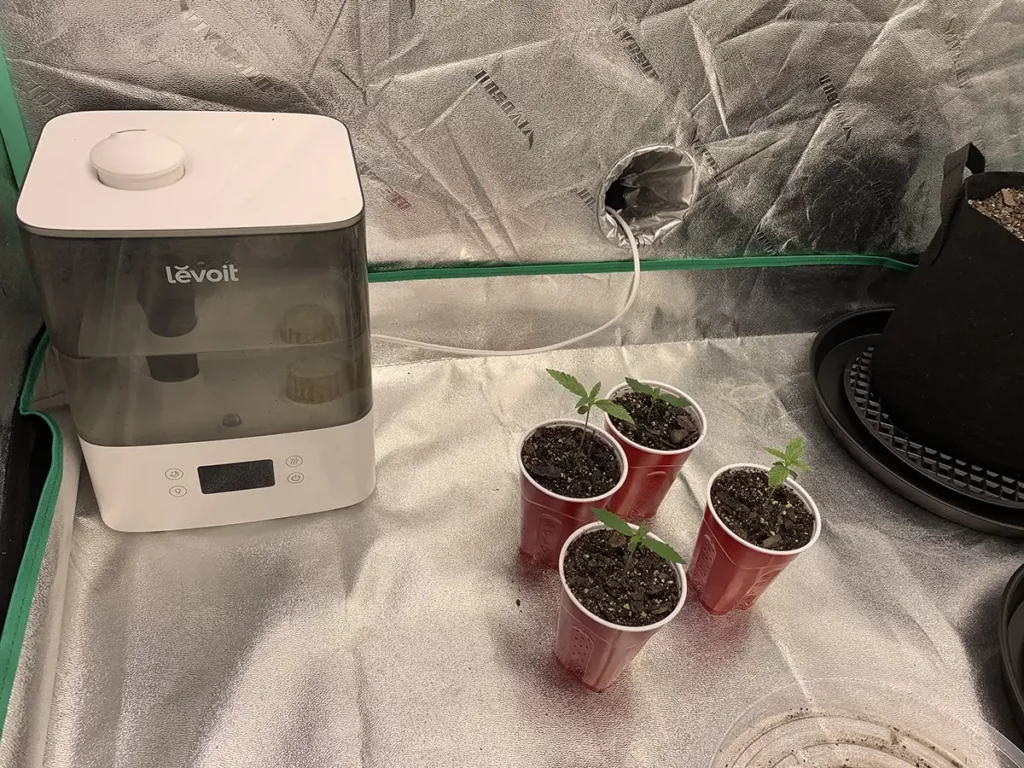
Once your lights and fans are installed, you can add additional climate control units as needed. A small humidifier can be placed inside the grow tent, and can be especially useful during the seedling and early vegetative stages when the plants require higher humidity.
Dehumidifiers can also be a useful tool, particularly during the late flowering stage when plants need relatively low humidity. Dehumidifiers should be placed just outside the tent to keep the plants from drying out excessively.
AC units and heaters should also be placed outside the tent, as most units will be too powerful to go in such a small space. Use thermometers both inside and outside the tent to monitor the temperature and adjust the heating and cooling accordingly.
How to Setup a Closet or Cupboard Grow Room
The first step in creating a closet or cupboard grow room is to line the walls with a reflective mylar film. This will maximize the light that your plants receive and allow them to receive light from all angles.
Lights should then be hung from the top of the closet or cupboard. A clothes rod can be used in a closet, or lights can be screwed directly into the top of the closet/cupboard. Similar to grow tents, 32 watts of LED lighting per square foot of space is ideal.
Unlike a grow tent, closet/cupboard grows often do not have any place to easily install an exhaust fan. Instead, you will likely have to focus on using 2 or more small oscillating fans to keep air flowing around the plants. All climate control units including humidifiers, dehumidifiers, AC units, and heaters will need to be placed just outside the closet or cupboard, as there will not be sufficient space for them on the inside.
How to Setup a Basic Light-Only Grow Space
One or two plants can be grown easily in a secluded room using nothing but a grow light and fixture. The light can be hung from the ceiling by a hook or mounted using a reptile lamp stand. The bulb can be placed in a wide brooder lamp fixture to better reflect the light down onto the plant.
One 100 watt LED should be sufficient for one plant, while a 200 watt LED can light two plants. The light should hang between 12-24 inches above the top of the plant depending on its age.
Humidifiers, Dehumidifiers, AC units, or heaters can be added to the room to control the climate around the plant(s). You will not need an exhaust fan for this setup, but one or more oscillating fans can be pointed at the plant to increase airflow.
How to Build a Full-Room Grow Room
For a full-room grow room, you can coat the walls, ceiling, and floor in reflective mylar film to maximize lighting, although this can be costly for a large room. LED lights can be mounted directly to the ceiling using the mounting equipment included with the fixtures.
Unlike closet or cupboard grows, larger grow rooms can accommodate humidifiers, dehumidifiers, AC units, and heaters directly inside the room in most cases. You will likely need a larger number of oscillating fans at both ground level and above the canopy to keep air flowing in a larger space.
Add Exhaust Fan(s) to the Grow Room
Exhaust fans can be mounted directly to the ceiling. Carbon filters can be attached to the fan, then the ducting can be directed out a window or into a different part of the house/ building.
Similar to grow tents, you will need an exhaust fan with a CFM sufficient to replace the air in the room at least once per minute. For a 6x10x8 room, you would need a fan with a 480 CFM rating. For particularly large rooms, you may need two exhaust fans to cover the entire room.
You may also choose to add an active intake fan to pull air from another room into the grow area. This will allow you to seal the grow room off more thoroughly and decrease odors escaping into other living areas.
Where to Put Carbon Filter in Grow Room?
Similar to grow tents, the carbon filter should be attached directly to the back of the exhaust fan on or near the ceiling. For best results, the carbon filter will need to be replaced every 6-12 months. Keeping the room reasonably clean and dust free will help extend the life of your filter.
Add Grow Lights to the Grow Room
Grow lights can be hung from the ceiling below the exhaust fan(s). They should ideally be mounted on an adjustable chain so they can be raised or lowered as the plants develop.
Like other growing methods, use approximately 32 watts of LED lighting per square foot of grow space. Adding reflective mylar to walls, floors, and ceiling will help increase diffusion of the light around the room.
How to Setup Circulating Fans in Grow Room?
You will need a minimum of two circulating fans in your grow room, preferably oscillating fans. One fan will point at the canopy of the plants while the other will point at the soil just above the rim of the pots.
You may need more than two fans if you notice any pockets of still air around the room. Excessive moisture buildup near delicate areas such as the roots or buds can cause fungal infections like root rot or bud rot.
Add a Humidifier, Dehumidifier, Portable AC Unit, and Heater to the room as needed to maintain proper humidity and temperatures. Plants will need relatively high humidity early in development and progressively lower humidity as they progress through the flowering stage.
How to Build a Sealed Grow Room?
For full room grow rooms, adding an opaque film over the windows can help block light and air from escaping the room. Zipper doors can be installed over the standard door to the room to further reduce air exchange with the outside.
Wrapping the walls and ceiling of the room in plastic can also keep air from escaping through porous drywall if you are still having odor concerns. However, investing in one or more grow tents may be more cost effective than wrapping the entire room.
For grow tents, adding an active intake vent and closing the passive intake vents will increase the air tightness of the tent. Creating a slightly negative air pressure inside the tent relative to the outside room will also reduce the amount of odor that escapes the tent.
How to Build a Grow Room in a Basement?
Basement grows can be constructed in much the same way as full room grows, although you will need to pay particular attention to temperature and humidity parameters. You will likely need a space heater to bring the temperature up to the upper 70s, as well as a dehumidifier if you have a damp basement.
Summary
The most common grow room types for home growers include a light only grow, one or more grow tents in a room, a converted closet or cupboard grow, and a full room grow.
Light only and converted closet/ cupboard grows are cost effective and take up relatively little space, although they offer less control over the growing conditions of the plant and tend to produce low yields.
In comparison, grow tents require greater initial investments of time and money, but also provide a more ideal growing environment for your plants. Grow tents have features such as bars to hang lights and fans, as well as zippered doors and vents for intake and exhaust air. Plants grown in grow tents tend to be healthier and produce higher yields than those grown in closets or cupboards.
The final option for home grows is to convert an entire room into your grow room. Although this can be costly and time consuming, it may be the best option for growing a large number of plants at the same time.

Rocky Horton
Author
Rocky Horton is an experienced cannabis grower and the founder of IndoGrow. The IndoGrow editorial team has over four decades of combined growing experience. Learn more.

